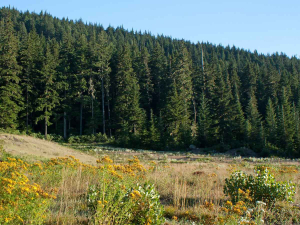Editorial: New Treeland?
OPINION: Forestry is not all bad and planting pine trees on land that is prone to erosion or in soils which cannot support livestock farming makes sense.
 New research led by a University of Canterbury academic has identified that conventional seed banking alone isn’t enough to conserve all of New Zealand’s endemic plants.
New research led by a University of Canterbury academic has identified that conventional seed banking alone isn’t enough to conserve all of New Zealand’s endemic plants.
New research led by a University of Canterbury academic has identified that conventional seed banking alone isn’t enough to conserve all of New Zealand’s endemic plants.
Dr Sarah Wyse, who lectures in the School of Forestry at the University of Canterbury (UC) says protection of the environment is the first line of defence for plant conservation with the preservation of native plant species in artificial seedbanks - known as ex situ conservation – as an important backup.
Her team’s research shows that 80% of New Zealand’s woody plant species can be successfully preserved using conventional seed banking, in which seeds are dried and frozen for long-term storage.
This accessible process can be undertaken by conservation groups and citizen scientists outside of laboratories as it doesn’t require specialized equipment or expertise.
However, seeds from some plants – especially New Zealand’s tall forest trees, with large bird-dispersed seeds, cannot be successfully conserved this way.
“Tropical rainforest seeds shed while they’re metabolically active so they can germinate quickly, but this makes them more problematic as you can’t dry or freeze them,” says Wyse.
“New Zealand has a number of trees closely related to tropical rainforest species, and these are the ones that may prove tricky,” she explains.
Conservation of these seeds requires more complex techniques such as cryopreservation, in which the seed embryo or other plant tissues are stored in liquid nitrogen. Currently, little is known about how to perfect that process of New Zealand native seeds.
Wyese says some of the forest taonga (treasures) that may pose difficulties for artificial seedbank construction include dominant canopy trees such as rimu, kohekohe, swamp maire, kahikatea, tōtara, and kauri.
As these species face additional threats from predation, pollinator extinction, climate change, and pathogens like myrtle rust and kauri dieback, effective ex situ conservation is critical.
While gaps in existing knowledge are concerning, Wyse says she is encouraged by the number of organisations committed to seed conservation.
In Canterbury, this includes Māori biosecurity initiative, Te Tira Whakamātaki, who bring significant mātauranga (Māori knowledge) to the field. She also notes a growing interest in seedbanks from arboretums and botanical gardens.
Dr Wyse’s research, coauthored with Thomas Carlin, Thomas Etherington, Aisyah Faruk, John Dickie, and Peter Bellingham, is published in the journal Pacific Conservation Biology.
The research was funded by a grant from the Ministry of Business, Innovation and Employment through New Zealand’s Biological Heritage National Science Challenge.
New Zealand needs a new healthcare model to address rising rates of obesity in rural communities, with the current system leaving many patients unable to access effective treatment or long-term support, warn GPs.
Southland farmers are being urged to put safety first, following a spike in tip offs about risky handling of wind-damaged trees
Third-generation Ashburton dairy farmers TJ and Mark Stewart are no strangers to adapting and evolving.
When American retail giant Cosco came to audit Open Country Dairy’s new butter plant at the Waharoa site and give the green light to supply their American stores, they allowed themselves a week for the exercise.
Fonterra chair Peter McBride says the divestment of Mainland Group is their last significant asset sale and signals the end of structural changes.
Thirty years ago, as a young sharemilker, former Waikato farmer Snow Chubb realised he was bucking a trend when he started planting trees to provide shade for his cows, but he knew the animals would appreciate what he was doing.

OPINION: Your old mate welcomes the proposed changes to local government but notes it drew responses that ranged from the reasonable…
OPINION: A press release from the oxygen thieves running the hot air symposium on climate change, known as COP30, grabbed your…